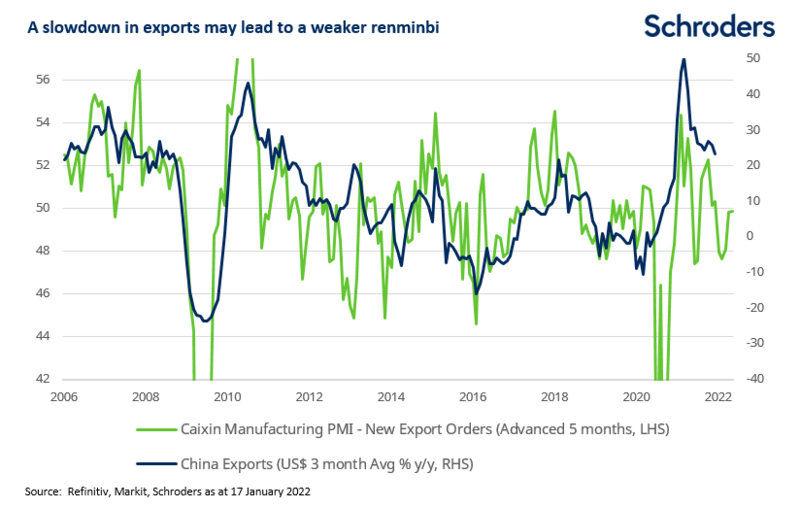China’s economy: light at the end of a long dark tunnel?
The latest data shows another quarter of slowing growth in China but activity could improve later this year.

Authors
Growth in China’s economy slowed to 4% year on year (y/y) in the fourth quarter of 2021. This is down from 4.9% in the third quarter, and a slowdown in exports, coupled with continued problems in the real estate sector, look set to weigh on activity in the near term.
The good news is that leading economic indicators appear to have troughed, consistent with a cyclical improvement in activity emerging in the summer. Meanwhile, today’s interest rate cut adds to the stimulus being put in place by the authorities. That should ultimately be good for markets.
How China’s economy performed in Q4 2021
According to the official data, GDP growth slowed to 4% y/y in the fourth quarter of last year, from 4.9% in Q3. The print was better than expected: the consensus forecast was for an increase of 3.6%, while we had expected growth to dip below 3%. Monthly activity data indicate that much of the upside surprise in the fourth quarter came from industry, where growth picked up to 4.3% y/y in December buoyed by robust export growth. The outturn meant that China’s economy expanded by 8.1% in 2021 as a whole, after powerful base effects boosted the annual rate of growth in the first half of last year.
Three reasons why activity may remain weak in the near term
We have been concerned for some time about a slowdown in China's economy, and there are at least three good reasons to think that activity will remain depressed in the near term.
1. Manufactured exports, which have been the key driver of growth during the pandemic, look set to slow. Growth in nominal exports remained resilient in December, registering growth of 20.9% y/y, down only slightly from an increase of 22% y/y in November. However, as the chart below shows, the depressed level of new export orders points to a deceleration in the months ahead. We believe that a slowdown in exports will result in a depreciation of the renminbi, which has appreciated sharply in trade-weighted terms during the past year. It is notable in this regard that the possibility of a weaker currency has now begun to be discussed through official government channels.

2. Problems in the real estate sector are likely to drag on for a while. Despite some marginal easing, government policy towards the sector remains tight. And sales of new housing, which typically lead construction activity by six to nine months, are yet to convincingly stabilise. Our assumption is that sales will stabilise at some point soon, and even pick up slightly during the course of the year, but further pain in the sector is a clear downside risk to our expectations.
3. Outbreaks of Covid-19 are likely to cause periodic bouts of disruption to activity. The government’s zero-tolerance policy has recently seen restrictions put in place in Tianjin, and the higher transmissibility of Omicron means that more cities will almost certainly be affected in the near future.
Is there light at the end of the tunnel?
However, it is not all doom and gloom, and the good news is that there is light at the end of tunnel. The credit impulse, which measures lending growth as a share of GDP, and real M1, which depicts the value of the most liquid components of the money supply, such as currency in circulation and overnight deposits, both rose in December. These indicators have historically led activity by around nine months, suggesting that a cyclical improvement in economic activity will begin to emerge late in the Northern hemisphere summer.
We expect further gradual increases in both leading indicators in the months ahead as fiscal and monetary policy become more supportive. The People’s Bank announced today that it was lowering the interest rate on both its 7-day reverse repo rate and one-year medium-term lending facility by 10bp each to 2.1% and 2.85% respectively. Those cuts followed a 5bp reduction in the one year loan prime rate in December, which is now likely to be followed by another 10bp cut next week. Our baseline forecast assumes a total of 20bp of cuts, which should lend support to activity, along with increased public spending. In line with this, we project a shallow recovery in GDP growth, from around 4.7% this year to 5% in 2023.
What does this mean for financial markets?
Evidence of a turnaround in China’s business cycle should eventually lend support to onshore financial markets and those further afield in the emerging world. However, like with economic activity, movements in leading indicators have historically fed through to financial markets with a lag and so there may yet be more bumps in the road.

Subscribe to our Insights
Visit our preference centre, where you can choose which Schroders Insights you would like to receive.
Authors
Topics